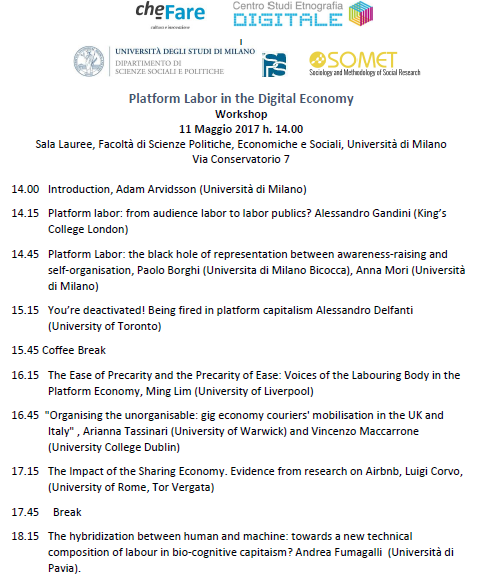After a couple of weeks of silence I am back with a post on the “gig economy” , focusing in particular on the food delivery sector. If you can read Italian you can skip this post and read directly the article which I published together with my co-author Arianna Tassinari on the Sunday edition of “Il Manifesto”.
On May 1st the food couriers of Deliveroo in Torino staged the second strike (to my knowledge) of the Italian gig economy, after the protest of Foodora’s rider in October 2016. Many of them “logged-out” from the app at the same time, and the company was unable to perform the delivery of food for some hours. In the past I wrote extensively about struggle of the riders of Foodora, a competitor of Deliveroo in this expanding market (see my post on Jacobin with Arianna).

(this image is from the Manifesto’s article)
This second strike is quite interesting for several reasons. Firstly, it shows that the fight of the hyperprecarious workers of the gig economy in Italy is still on, despite the limited outcomes of the Foodora’s strike (more on this will follow). Secondly, the grievances which triggered the protest shows that despite the innovative look that this start-ups try to maintain, they often use “old” work practices. In fact, the workers were contesting the system for assigning shifts which Deliveroo put in practice in Torino, which was very rigid and far from the mythology of “algorithmic management” (if you understand Italian you can read the workers’ demand here). Here is what the workers say. In the first week of work, they were asked to indicate their availability for the different shifts. After the first week, the table with their shifts have been simply copied-and-pasted also for the following weeks. As a result, if for whatever reason a worker could not fill her shift, she would most likely loose it and it would have been very hard for her to get it back. So much for the flexibility of the gig economy! If anything, this rather paradoxical result shows once again that the claim that food couriers are independent contractors (they are hired as parasubordinate workers in the Italian system) might be soon challenged in the labour courts.
